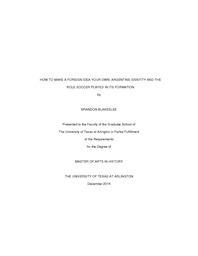
ATTENTION: The works hosted here are being migrated to a new repository that will consolidate resources, improve discoverability, and better show UTA's research impact on the global community. We will update authors as the migration progresses. Please see MavMatrix for more information.
Show simple item record
| dc.contributor.author | Blakeslee, Brandon Todd | en_US |
| dc.date.accessioned | 2015-07-01T17:50:17Z | |
| dc.date.available | 2015-07-01T17:50:17Z | |
| dc.date.issued | 2014-12 | |
| dc.date.submitted | January 2014 | en_US |
| dc.identifier.other | DISS-12855 | en_US |
| dc.identifier.uri | http://hdl.handle.net/10106/24899 | |
| dc.description.abstract | Since Spanish-speaking Latin America achieved independence from Spain the question has been whether to follow the North American or European example. Do the new republics embrace the Old World with its aristocracy or the meritocracy of the United States? To choose one, was to dismiss the other, or so the debate went. However, there are points of contact between the Old-and-New Worlds.Argentine soccer proves a potent example of something that is not wholly one or the other but a combination of both. Though developed exclusively in England, Argentina claims soccer as their national sport. A truly pervasive concept, all parts of Argentine society participate in the sport in some way shape or form. Not only are all sectors included but Argentines use soccer as a means to protest what they see as British aggression. The intercultural transfer model helps dissect the process by which a European activity becomes an inseparable part of Argentine culture. Intercultural transfer shows how an idea or an object moves from one culture and alters and is altered by the culture it's moved two, differentiating both. | en_US |
| dc.description.sponsorship | Adam, Thomas | en_US |
| dc.language.iso | en | en_US |
| dc.publisher | History | en_US |
| dc.title | How To Make A Foreign Idea Your Own: Argentine Identity And The Role Soccer Played In Its Formation | en_US |
| dc.type | M.A. | en_US |
| dc.contributor.committeeChair | Adam, Thomas | en_US |
| dc.degree.department | History | en_US |
| dc.degree.discipline | History | en_US |
| dc.degree.grantor | University of Texas at Arlington | en_US |
| dc.degree.level | masters | en_US |
| dc.degree.name | M.A. | en_US |
Files in this item
- Name:
- Blakeslee_uta_2502M_12855.pdf
- Size:
- 593.7Kb
- Format:
- PDF
This item appears in the following Collection(s)
Show simple item record


